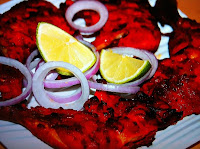This is the short adventure around Sydney's most exciting food destination. Hope you enjoy our video.
If you have any requires, just let us know and we will go have a bite.
 Satay or sate, is a dish marinated, skewered and grilled meat, served with a sauce. Satay may consist of diced or sliced chicken, goat, mutton, beef, pork, fish, other meats, or tofu; the more authentic version uses skewers from the midrib of the coconut palm frond, although bamboo skewers are often used. These are grilled or barbecued over a wood or charcoal fire, then served with various spicy seasonings.
Satay or sate, is a dish marinated, skewered and grilled meat, served with a sauce. Satay may consist of diced or sliced chicken, goat, mutton, beef, pork, fish, other meats, or tofu; the more authentic version uses skewers from the midrib of the coconut palm frond, although bamboo skewers are often used. These are grilled or barbecued over a wood or charcoal fire, then served with various spicy seasonings. Mapo doufu is a popular Chinese dish from the Szechuan province and probably the most famous dish in western countries. This dish combined with doufu cook in a spicy chili- and bean-based sauce, typically a thin, oily, and bright red suspension, and often cooked with fermented black beans and minced meat, usually pork or beef.
Mapo doufu is a popular Chinese dish from the Szechuan province and probably the most famous dish in western countries. This dish combined with doufu cook in a spicy chili- and bean-based sauce, typically a thin, oily, and bright red suspension, and often cooked with fermented black beans and minced meat, usually pork or beef.  The rack of lamb is one of the most prized and tender cuts of meat. Racks are relatively simple to prepare and quick to cook. Rack of lamb is considered the most famous dish in a western menu. Usually the rack of lamb is prepared in a garlic-herb-honey-mustard crust. It a great-tasting show-stopper and give you a taste that’s explodes in your mouths. The taste is by far exquisite. However the rack of lamb must be prepared well giving a tender, rare lamb that is at a pink state when you slice the meat. It will melt like butter when it touches your tongue and “wow” felling will force you to be craving for more after a slice. Therefore it’s a must try dish, however you need the right restaurant to serve it to give you a moment of fantasy after a bite.
The rack of lamb is one of the most prized and tender cuts of meat. Racks are relatively simple to prepare and quick to cook. Rack of lamb is considered the most famous dish in a western menu. Usually the rack of lamb is prepared in a garlic-herb-honey-mustard crust. It a great-tasting show-stopper and give you a taste that’s explodes in your mouths. The taste is by far exquisite. However the rack of lamb must be prepared well giving a tender, rare lamb that is at a pink state when you slice the meat. It will melt like butter when it touches your tongue and “wow” felling will force you to be craving for more after a slice. Therefore it’s a must try dish, however you need the right restaurant to serve it to give you a moment of fantasy after a bite. A must try is also their
teh tarik which is made in front of the customers, especially when the teh
tarik maker’s a bit of a showman and pulls the tea with a flourish from cup to
cup at quite spectacular heights.
A must try is also their
teh tarik which is made in front of the customers, especially when the teh
tarik maker’s a bit of a showman and pulls the tea with a flourish from cup to
cup at quite spectacular heights.  Tandoori Chicken is a very popular dish in most of the Asian Countries like Malaysia, India, Singapore... you name it.
Tandoori Chicken is a very popular dish in most of the Asian Countries like Malaysia, India, Singapore... you name it. Welcome everyone to this blog. We are here to talk all types of food and post up interesting dishes from all corner on the world. Please follow us as we discover the different taste and experience when we dine.
Welcome everyone to this blog. We are here to talk all types of food and post up interesting dishes from all corner on the world. Please follow us as we discover the different taste and experience when we dine.